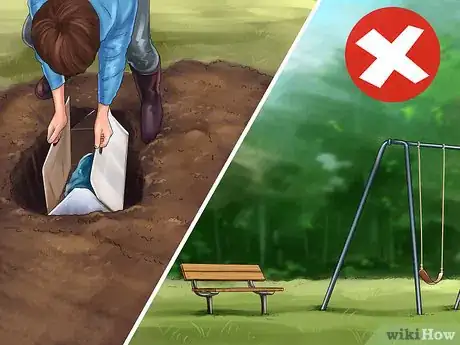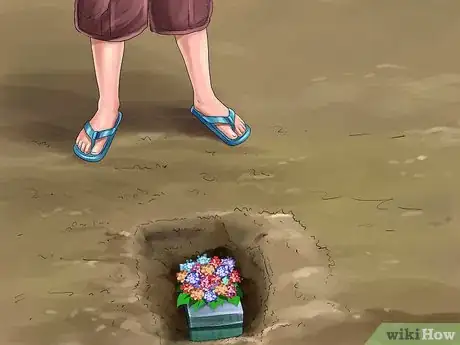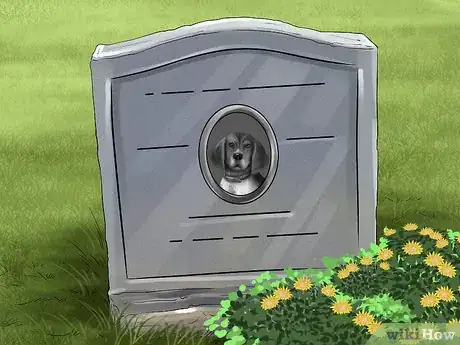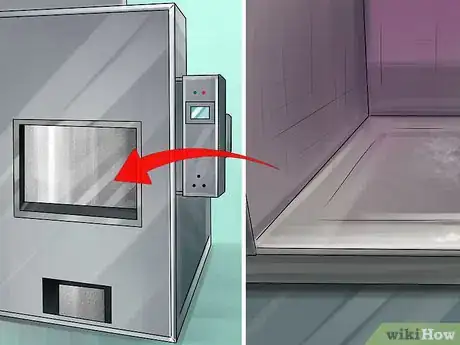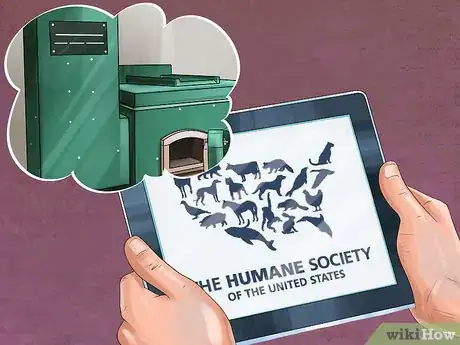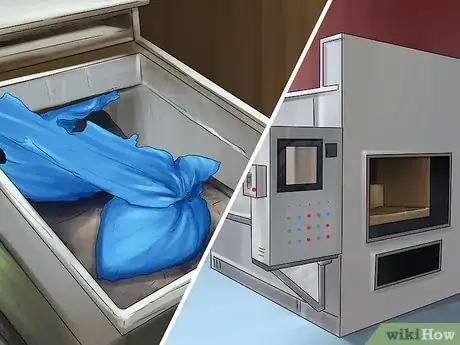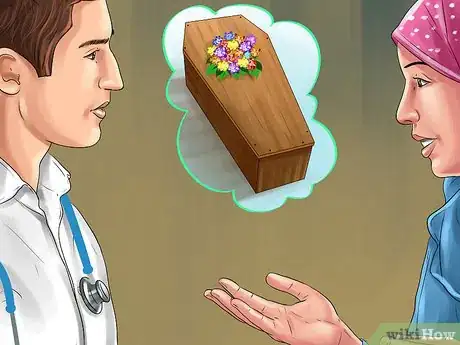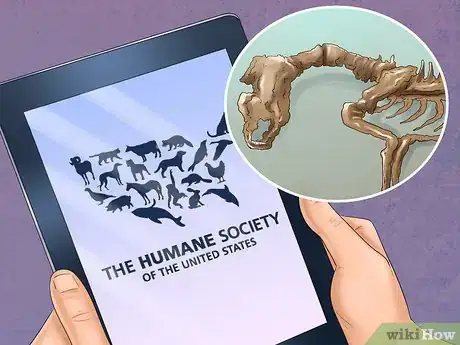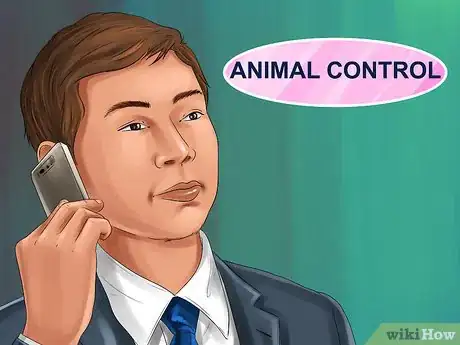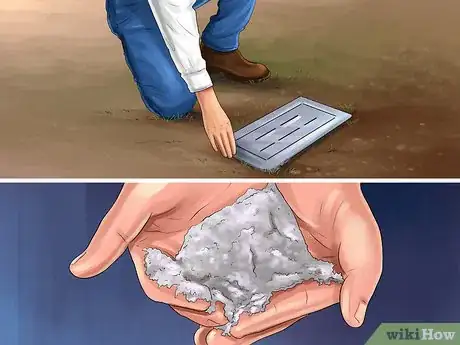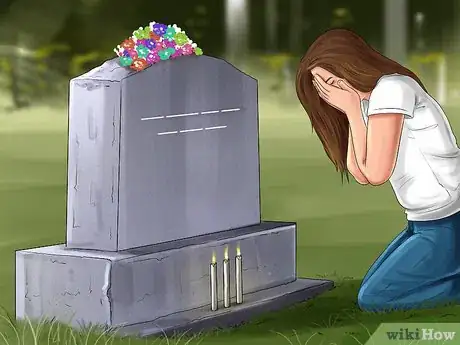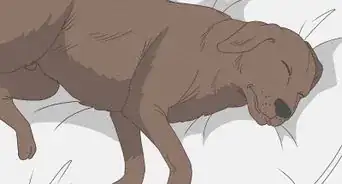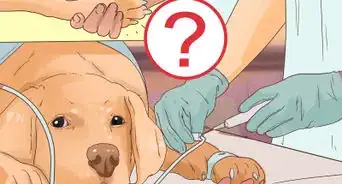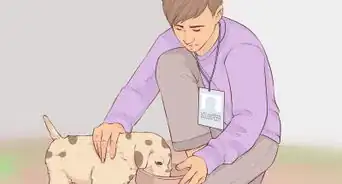This article was co-authored by Pippa Elliott, MRCVS. Dr. Elliott, BVMS, MRCVS is a veterinarian with over 30 years of experience in veterinary surgery and companion animal practice. She graduated from the University of Glasgow in 1987 with a degree in veterinary medicine and surgery. She has worked at the same animal clinic in her hometown for over 20 years.
This article has been viewed 28,993 times.
The death of a dog is a difficult situation to go through. Not knowing what to do with their remains can make it even more difficult. The most common ways of disposing of your dog's remains include burial and cremation. However, you can also get help from animal control, the humane society, or your veterinarian.
Steps
Burying Your Dog
-
1Bury your pet. You may decide you want to bury your pet in your yard or on your land. This is a way to deal with your dog's remains while giving you a place to visit and remember them. The burial process can also help you to grieve and let go.[1]
- Find out what the laws are about burying your pets on your property. Some areas don't allow it, such as in populated cities.
- Never bury a pet on public lands, like in a park. This is generally illegal.
-
2Choose an appropriate place for the burial. If you want to bury your dog on your land, you should choose a good place to bury them. You want to make sure it is a place that won't be dug up by other pets since this can cause a health hazard. If you want to place them in a pet cemetery, you should buy a burial plot from the cemetery.
- For example, if you want to be able to walk to the spot but not see it every day, consider placing it somewhere you won't be able to see as you walk to your car or from windows. If you would like to see it often, choose a place you can see easily every day.
- If your pet had a favorite spot in your yard or on the property, you can choose to bury them there.
- If you rent your home, you may not want to bury your dog there in case you move.
Advertisement -
3Dig the grave. If you have not cremated your dog, you should place a plastic bag or tarp around their body. Measure them so that you can dig a grave that is large enough. If you cremated them, you can simply bury the urn. Dig a grave that is at least 3–4 feet (0.91–1.22 m) deep.[2]
- Wait at least a few hours after death before you bury them.
-
4Place a marker for the grave. After you bury your dog, you may want to place a marker of some sort on top of the grave. This may be a homemade marker, a statue, or even a tree or shrub. Some companies offer headstones for pet graves that you can purchase.
-
5Find a pet cemetery. If you want to bury your pet but do not have anywhere to bury it, you can try to find a pet cemetery or pet memorial park. These are areas designated specifically for pet burials. You can purchase a plot so you can bury and memorialize your pet.[3]
- Ask your vet if they know of any pet cemeteries or memorial parks in your area.
- You may also want to contact the local humane society or animal control for information of finding one of these places in your area.
- Most plots cost around $100 for small dogs. You will also need to provide a casket for the dog.
Cremating Your Dog
-
1Consider pet cremation. You may choose to have your pet cremated after they have died. There are pet cremation services who can do this for you. When you cremate your pet, you do not have to deal with burying your pet.[4]
- Pet cremation may be a good choice if you want to keep the ashes.
- Pet cremation is also way a to deal with your pet's remains when you cannot bury your pet anywhere.
-
2Find a pet crematory. Pet crematories are available in many cities. Often, the pet crematory will come get the remains of your pet from your home or the veterinarian's office. Many vet offices provide cremation services if the pet died there was euthanized in the office. However, this may come at an additional expense.
- Search online for a pet crematory service in your area, ask your vet, or contact the local humane society.
-
3Choose the type of cremation. There are different types of dog cremations. The types include private, semi-private, and communal. The choice depends on whether you want to keep your dog's ashes in an urn and the price you want to pay.[5]
- A private cremation means your dog is in a chamber alone. If you want to keep your dog's ashes in an urn, this may be the choice for you. However, this process is the most expensive and can reach up to $400.
- A semi-private cremation places multiple dogs in the same chamber in different partitions. During this process, the ashes can end up mixing together slightly. Some places advertise this as private cremation, so you may want to discuss what private means when talking to the crematory. The price for this process can reach up to $250.
- A communal cremation is when they place multiple pets into the same chamber so all of the ashes are combined. You will not receive an urn after this process. This is the cheapest option.
-
4Decide what to do with the ashes. After your dog has been cremated, you have multiple options for what to do with the ashes. You can bury the ashes in your yard. You may decide to spread the ashes somewhere, like in your yard, in the woods, or in water. You can also keep the ashes in your home in a decorative urn.
- You can find pet urns online and in pet magazines.
Finding Other Ways to Handle Your Dog's Remains
-
1Find out if the vet will dispose of remains. If you are unable to dispose of the remains or care more about your pet's spirit than the actual physical remains, you may want to find someone else to deal with the remains. Your vet may offer to handle the remains if the dog dies in the office.[6]
- Some vets may charge a small fee if the dog didn't die at their office. This will cover the cost of cremation. Some vets do not charge this fee, however.
-
2Get the humane society to help with your dog's remains. Your local humane society may take the remains of dead pets. They may come to pick up the remains, or you may have to carry them at the office. This is often offered free of charge.
- Some humane societies have “drop off” bins for your pet, but many people find these bins to be too impersonal and choose to take them during house so they can hand them off to a person.
-
3Contact animal control for help with the remains. If your pet has died, you may not have anywhere to bury them, and you may not wish to have them cremated. If this is the case, contact animal control or your local government to ask if someone, like the sanitation department, can pick up the remains.[7]
- Never toss your dog's remains on the side of the road, in a dumpster, or in the woods. Always find a way to dispose of them properly. If you are unsure how, contact your local government for help.
Determining How to Handle the Remains
-
1Decide ahead of time how to handle the remains. You never want to think about your beloved dog dying, but deciding what you want to do when the inevitable happens can save you some hardship when it happens. When your dog dies, you may not be prepared to think about what you want to do with their remains. Figuring it out ahead of time can help reduce stress at a difficult time for you.
- If you've never thought about what to do with your pet's body, you may want to talk with your family about the best way to deal with the remains.
- For example, if the dog has to be euthanized at the vet, you should think about what you will tell the vet when they ask you what you want to do with your dog's remains.
-
2Determine your feelings on the remembrance of your pet. Part of the decision of what to do with your dog's remains is based on how you want to deal with the death, loss, and memory of your dog. This is different for everyone. You have to decide how you feel most comfortable dealing with your pet's death and memory.
- For example, if you want a spot to go visit to think about your pet, you may want to bury them in your yard or in a pet cemetery. If you want to preserve the ashes in your home or spread them somewhere, you may want to consider cremation.
-
3Talk about what to do with your dog's remains with your family. Because your pet may not belong only to you but the whole family, make the decision together. This can make sure that all of the needs and beliefs of your family are met during this difficult time.
- For example, if you don't have strong feelings about your pet's physical remains but your family member wants to honor them, you may choose to bury the dog and have a small memorial service to help your family member cope.
References
- ↑ http://www.aspca.org/pet-care/general-pet-care/end-life-care
- ↑ https://www.dfordog.co.uk/blog/pet-dog-home-burial.html
- ↑ http://www.aspca.org/pet-care/general-pet-care/end-life-care
- ↑ http://www.aspca.org/pet-care/general-pet-care/end-life-care
- ↑ http://www.caninejournal.com/dog-cremation/
- ↑ http://www.dogbreedinfo.com/timetoletgo.htm
- ↑ http://www.aspca.org/pet-care/general-pet-care/end-life-care
About This Article
To handle your dog's remains, consider burying them on your land and placing a marker over the grave so you can visit it when you're missing your dog. Alternatively, if you don't have land to bury your dog on, you can purchase a plot at a pet cemetery so you can still visit your dog's grave. You can also have your dog cremated by a pet cremation service and then keep the ashes in an urn in your home. Or, you can spread the ashes somewhere that was special to your dog. If you're not interested or able to keep your dog's remains, you can ask a local vet or humane society to dispose of them for you. For advice from our Veterinary co-author, like how to decide what to do with your dog's remains, read on.
